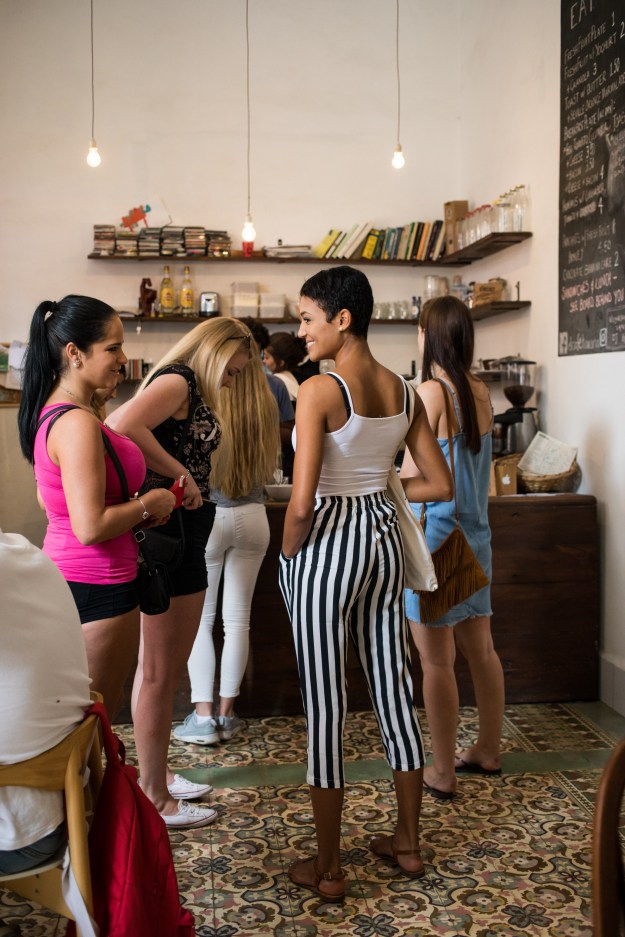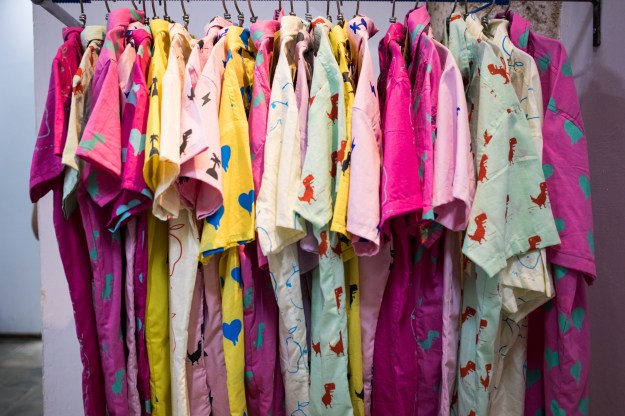Humor, antiquity, music, art, laughter, the sea: Havana is all that and much more. It was founded in 1514 in its excellent location around the bay, and there remain pieces of the original city wall (built in the 17th century), several of its first buildings, its cobblestone streets, and majestic Spanish architecture.
Today, with more than 2 million inhabitants, the city strives toward modernity. Despite its outdated infrastructure—or maybe because of it—Havana is a magical city.
In the last three years, Havana has become distinctly fashionable: It’s been the setting of a Fast and Furious shoot, a Chanel runway show, Usher’s wedding, and Madonna’s 58th birthday party. Every day more foreigners move to Havana, lured by its people, safety, culture, and business opportunities; while local entrepreneurs supply new services that didn’t previously exist here along with programs to improve and empower their communities.
This hidden gem on Amargura Street serves the most amazing breakfast in Havana. You have many options, from pancakes with fresh fruit to veggie or meat sandwiches. And eggs, of course. My favorite is the vegan avocado sandwich with hummus and green peppers on homemade sourdough bread with a fresh-squeezed orange-carrot-ginger juice. The relaxed environment, with shared tables and wooden chairs in a 1920s neocolonial house-turned-hipster-cafe, is the ideal place to enjoy breakfast before you start your walk around La Habana Vieja (Old Havana). Finish with a perfect strong Cuban coffee and let the journey begin!


You cannot visit Havana and not tour the Old City. For a good start, pay a visit to Clandestina, a boutique that sells T-shirts, bags, pillowcases, and other goods that convey the daily problems of Cubans through graphic design and a singular sense of humor. Then take a walk down Teniente Rey, heading toward the sea, to visit the four main plazas. Along the way, stop in El Museo de la Farmacia Habanera (The Museum of Havana Pharmacy), one of the largest and most beautiful pharmacies in the world. Founded in 1886 and restored in 2004, it is today both a pharmacy and a museum. Walk another five minutes to reach Plaza Vieja (Old Square). Totally restored, this plaza was founded in 1559 and served as a market at the end of the 17th century. It is Old Havana’s largest plaza and surrounded by colorful buildings and cafes.
Continue walking toward Plaza de San Francisco de Asís, filled with pigeons most of the day. You’ll also find the San Francisco de Asís basilica, an 18th-century church that’s now a classical-music concert venue, and the Lonja del Comercio (Commerce Market), the former stock-exchange building with an eclectic character.



Take a short detour down Mercaderes Street on your way to Plaza de Armas. In addition to carts selling churros, roasted corn, and other Cuban delights, you’ll find the Museo Armería 9 de Abril, a gun shop founded in 1934 that’s now a museum that exhibits guns from the 18th to 20th centuries. At the 1791 Havana Perfume House, you can concoct your own signature scent. Along this street you’ll also find the miniature model of Habana Vieja in the Marqueta de La Habana building, and in the Ambos Mundos hotel, they keep Hemingway’s room as a small museum.
Plaza de Armas, the administrative center of colonial Havana, welcomes visitors with leafy trees and shaded benches. Its main building, the Palace of the Captain-General, was the former home of the Spanish rulers and is a museum today. The palace is surrounded by the Castillo de la Real Fuerza, the first fortress of the city; the Segundo Cabo, a colonial palace; and the Templete, a Doric chapel built at the spot where the city’s founding Mass took place in 1519.
Exit Plaza de Armas via O’Reilly Street and turn right on San Ignacio to find the Cathedral of Havana, built in 1777, in the Plaza de la Catedral. The square was once a swampy area, which was drained to build a chapel. In the 18th century it became the cultural center of the town and the site of bullfights, theater performances, canonizations, and so on. The cathedral is a baroque masterpiece. Its facade was sculpted in coral and is dominated by two uneven towers. Its interior is more neoclassical than baroque. Next to the plaza, the former Zanja Real aqueduct, where residents used to go for water, now hosts the Callejón del Chorro, an alley filled with small restaurants and venues, including the Experimental Graphic Workshop. Spend a few minutes watching artists at work, and if you’re tempted, take a piece with you.
After touring 400 years in under three hours, it’s time for lunch. Head back to O´Reilly Street to find El del Frente. Don’t let the narrow door fool you. Go upstairs and find yourself in a large air-conditioned room, curiously decorated with contemporary art and a trendy bar with the true artist of the moment: the barman. Fruit mojitos and daiquiris are the specialty—my favorite is the mango. To eat I always get chicken and rice croquettes and tostones to start, then mixed tacos or the fish of the day with vegetables as a main course. If you like seafood, order the cold lobster tacos, another house specialty.


2:00pm
Soak up Cuban art at the National Museum of Fine Arts
Trocadero St. between Zulueta St. and Monserrate St.
Take a bicitaxi to the Museo Nacional de Bellas Artes, which exhibits over 30,000 works by Cuban artists from the colonial period up till today. Take an hour to wander around, and don’t miss the contemporary-art section, where you can appreciate paintings by René Portocarrero, Wifredo Lam, and Amelia Peláez, among others.
3:00pm
Ride in a vintage convertible
You cannot say you’ve been to Havana without the requisite taxi ride in a ’50s convertible. Make a left when you exit the museum and take one of these vintage treasures—I always try to get a red Ford Impala—along the Malecón to the Jaimanitas neighborhood, where renowned artist José Fuster lives. Breathe in the fresh seaside air as the city’s colorful cast of characters appears before your eyes: fishermen, musicians, families, lovers. … Capture the vibe of the city pulsing in each person.

The entrance to Jaimanitas always surprises first-time visitors. Fuster has decorated the facade of more than 80 homes in such a way that makes us think of the Park Güell in Barcelona. Inspired by Gaudí and Brancusi, the artist has turned his house into a huge park of sculptures, paintings, and extraordinary viewpoints.

On the way back, ask your driver to take you to Plaza de la Revolución, first driving by the Bosque de la Habana (Havana Forest), a natural wonder that surrounds the Almendares River. When you reach the plaza, you will be in one of the largest plazas in the world at 775,000 square feet, crowned by a monument to Jose Martí, our apostle. At the foot of the marble statue is the platform where the current president salutes and addresses the Cuban people every May 1. It’s where Fidel Castro delivered many speeches and where two popes (John Paul II and Francis) have held Mass. The famous images of Che Guevara and Camilo Cienfuegos, heroes of the Cuban revolution, are also exhibited at the headquarters of the Ministries of the Interior and Communications, surrounding the plaza and just in front of the Martí statue, respectively.

Ask your driver to drop you at the Hotel Nacional de Cuba, a landmark built in 1930 with eclectic architecture disguised as art deco. The mix of styles inside is an elegant and luxurious combination, worthy of the guests it has welcomed. In 1946 the hotel was the venue of one of the most important mafia meetings, gathering the five most important capos of New York. Other guests have included Lucky Luciano and Meyer Lansky, Winston Churchill, and Buster Keaton. The gardens overlooking the Malecón are a perfect spot to have a mojito while watching the Havana sunset.
Take a taxi to La Guarida, Havana´s most famous private restaurant. What was once a small urban palace in the early 1900s was turned into a multifamily apartment building in Centro Habana. In 1993 one of its apartments was chosen as the main location for the internationally known Cuban film Fresa y Chocolate. Three years later owner Enrique Núñez opened a paladar (what Cubans called private restaurants in the ’90s, when the government first allowed them) with only 12 seats, as required by the regulations of the time. La Guarida kept growing and today has a reputation as one of the best and most elegant restaurants in Havana. The tall walls are covered with contemporary Cuban art and pictures of the many national and international figures who have tasted its cuisine. As a starter, I recommend the smoked-marlin tacos or eggplant caviar. For the main course, try the three tenderloins with green pepper, blue cheese, and chocolate sauces. Dessert is a must here. My favorites are the lemon and butter ice cream, tart with ice cream in coconut soup, and chocolate fondant.
Take a taxi to the Vedado neighborhood for this rooftop bar in an old vegetable-oil factory guarded by a huge brick chimney. Relax and chat on a sofa or butterfly chair near installations by artists Arlés del Río and Damian Aquinas, enjoying the drinks and perfect playlist. If you still have the energy after a long day, head next door to Fábrica de Arte Cubana (Factory of Cuban Art), or F.A.C. for short. Created by musician and director X Alfonso, with capacity for 2,000 people, Fábrica brings live music, DJs, art galleries, cinema, theater, and fashion all under one roof, and it’s open until 3 a.m.
